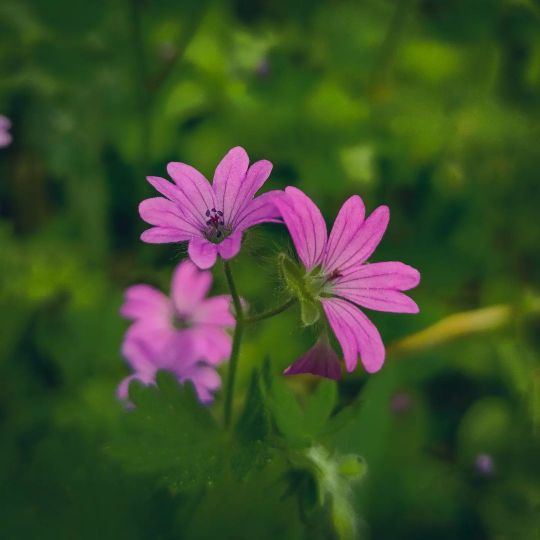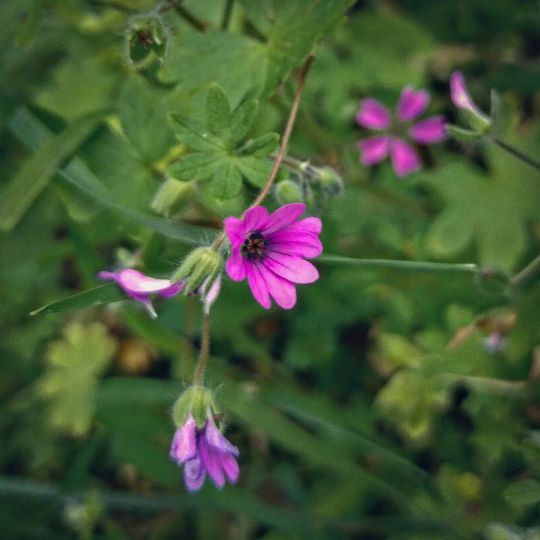#dovefoot geranium
Explore tagged Tumblr posts
Text
One of my most prolific garden weeds out here in BC, Canada! Fun fact: if you tincture it, the tincture turns an absolutely gorgeous shade of emerald.
#2506 - Geranium molle - Dove's-foot Crane's-Bill

AKA Awnless Geranium, and a very long list of synonyms.
Originally native to the Mediterranean area, but now widespread, thriving as a weed in drier sandy soils in sunny positions. It's been naturalised in New Zealand since at least 1852.
Ōwhiro Bay, Wellington, New Zealand
65 notes
·
View notes
Photo

Geranium molle, growing wild! Read more below about this fascinating herb. Learn more about our online courses on herbal medicine & aromatherapy in jointheflow.net Discover my books on bodywork and more: amzn.to/3xhaNey Its common name is Dovefoot Geranium, or Dove's-foot Crane's-bill. Nicholas Culpeper in his herbal of 1652 suggested a variety of uses for G. molle, including the treatment of internal and external injuries. A note was made that the bruised leaf healed external injuries faster. A decoction in wine was said to relieve gout and other joint pains. The plant is considered to be anodyne, astringent and vulnerary. In fact, you can use it as a tannin in herbal formulas, along with Quercus and Capsella. The bees LOVE the plant. It actually produces a kind of dark pollen. Geranium molle is a small plant reaching on average 5–30 centimetres (2.0–11.8 in) in height. It is a very branched plant, quite hairy, with several ascending stems. The leaves are palmate, cut 5 to 9 times. The basal leaves are arranged in a rosette, the upper ones are sessile, rounded and hairy, with a long petiole of about 5–12 millimetres (0.20–0.47 in). The flowers are pinkish-purple, 8–12 mm in diameter, with very jagged petals. It blooms from April to September. The flowers are hermaphrodite and mainly pollinated by Hymenoptera. Fruits are glabrous, usually with 6-9 transverse ridges. Photo taken by me, all rights reserved. #geranium #geraniummolle #geraniaceae #tannin #wildmedicine #greekflora #greekherbs #herbnerd #wildherbs #botany #botanicalmedicine��#medicinalherbs #myherbalstudies #healingherbs #foraging #herbalistsofinstagram #herbalremedies #primitiveskills #survivalskills #urbanherbalist #herbalremedies #apothecary #ethnobotany #ethnobotanist (at Athens, Greece) https://www.instagram.com/p/Cgq4lW_IsZL/?igshid=NGJjMDIxMWI=
#geranium#geraniummolle#geraniaceae#tannin#wildmedicine#greekflora#greekherbs#herbnerd#wildherbs#botany#botanicalmedicine#medicinalherbs#myherbalstudies#healingherbs#foraging#herbalistsofinstagram#herbalremedies#primitiveskills#survivalskills#urbanherbalist#apothecary#ethnobotany#ethnobotanist
2 notes
·
View notes
Photo

Bico-de-pomba-menor // Dovefoot Geranium (Geranium molle) from Valter Jacinto | Portugal http://ift.tt/2nR4GMu
0 notes
Photo

Geranium molle, growing wild! Read more below about this fascinating herb. Learn more about our online courses on herbal medicine & aromatherapy in jointheflow.net Discover my books on bodywork and more: amzn.to/3xhaNey Its common name is Dovefoot Geranium, or Dove's-foot Crane's-bill. Nicholas Culpeper in his herbal of 1652 suggested a variety of uses for G. molle, including the treatment of internal and external injuries. A note was made that the bruised leaf healed external injuries faster. A decoction in wine was said to relieve gout and other joint pains. The plant is considered to be anodyne, astringent and vulnerary. In fact, you can use it as a tannin in herbal formulas, along with Quercus and Capsella. The bees LOVE the plant. It actually produces a kind of dark pollen. Geranium molle is a small plant reaching on average 5–30 centimetres (2.0–11.8 in) in height. It is a very branched plant, quite hairy, with several ascending stems. The leaves are palmate, cut 5 to 9 times. The basal leaves are arranged in a rosette, the upper ones are sessile, rounded and hairy, with a long petiole of about 5–12 millimetres (0.20–0.47 in). The flowers are pinkish-purple, 8–12 mm in diameter, with very jagged petals. It blooms from April to September. The flowers are hermaphrodite and mainly pollinated by Hymenoptera. Fruits are glabrous, usually with 6-9 transverse ridges. #geranium #geraniummolle #geraniaceae #tannin #wildmedicine #greekflora #greekherbs #herbnerd #wildherbs #botany #botanicalmedicine #medicinalherbs #myherbalstudies #healingherbs #foraging #herbalistsofinstagram #herbalremedies #primitiveskills #survivalskills #urbanherbalist #herbalremedies #apothecary #ethnobotany #ethnobotanist (at Athens, Greece) https://www.instagram.com/p/CatpuyAMxrL/?utm_medium=tumblr
#geranium#geraniummolle#geraniaceae#tannin#wildmedicine#greekflora#greekherbs#herbnerd#wildherbs#botany#botanicalmedicine#medicinalherbs#myherbalstudies#healingherbs#foraging#herbalistsofinstagram#herbalremedies#primitiveskills#survivalskills#urbanherbalist#apothecary#ethnobotany#ethnobotanist
0 notes